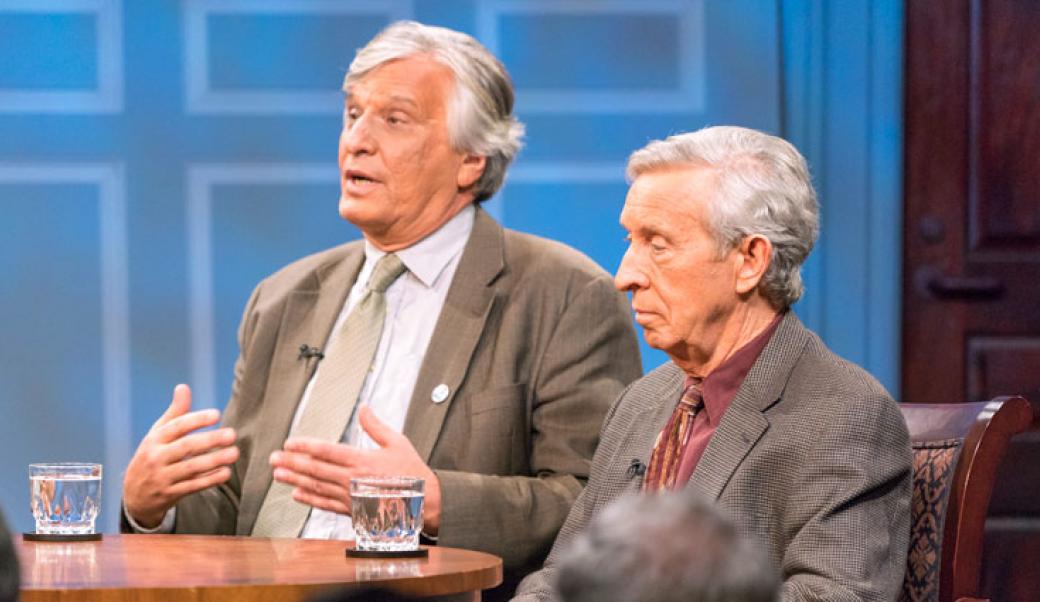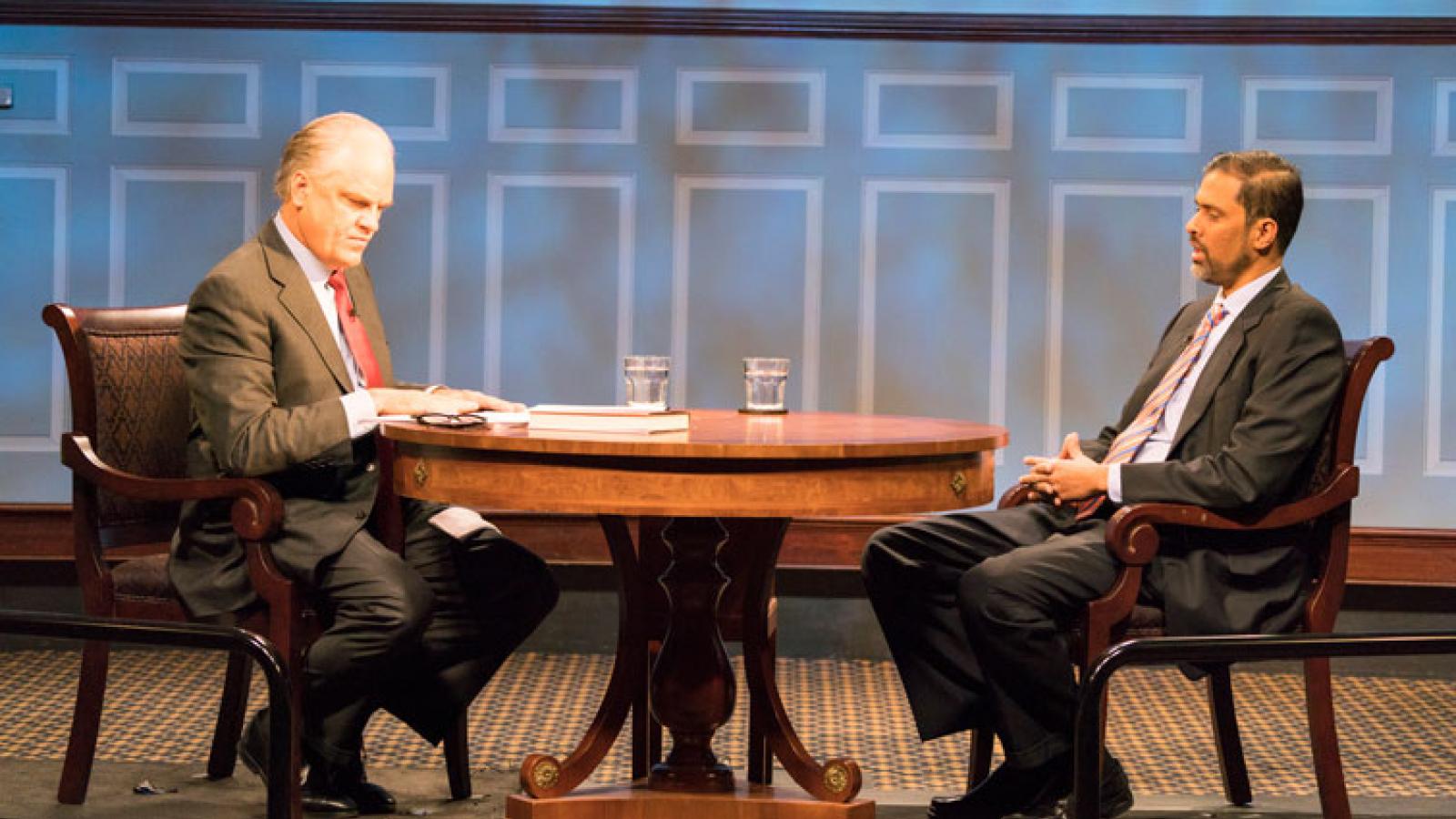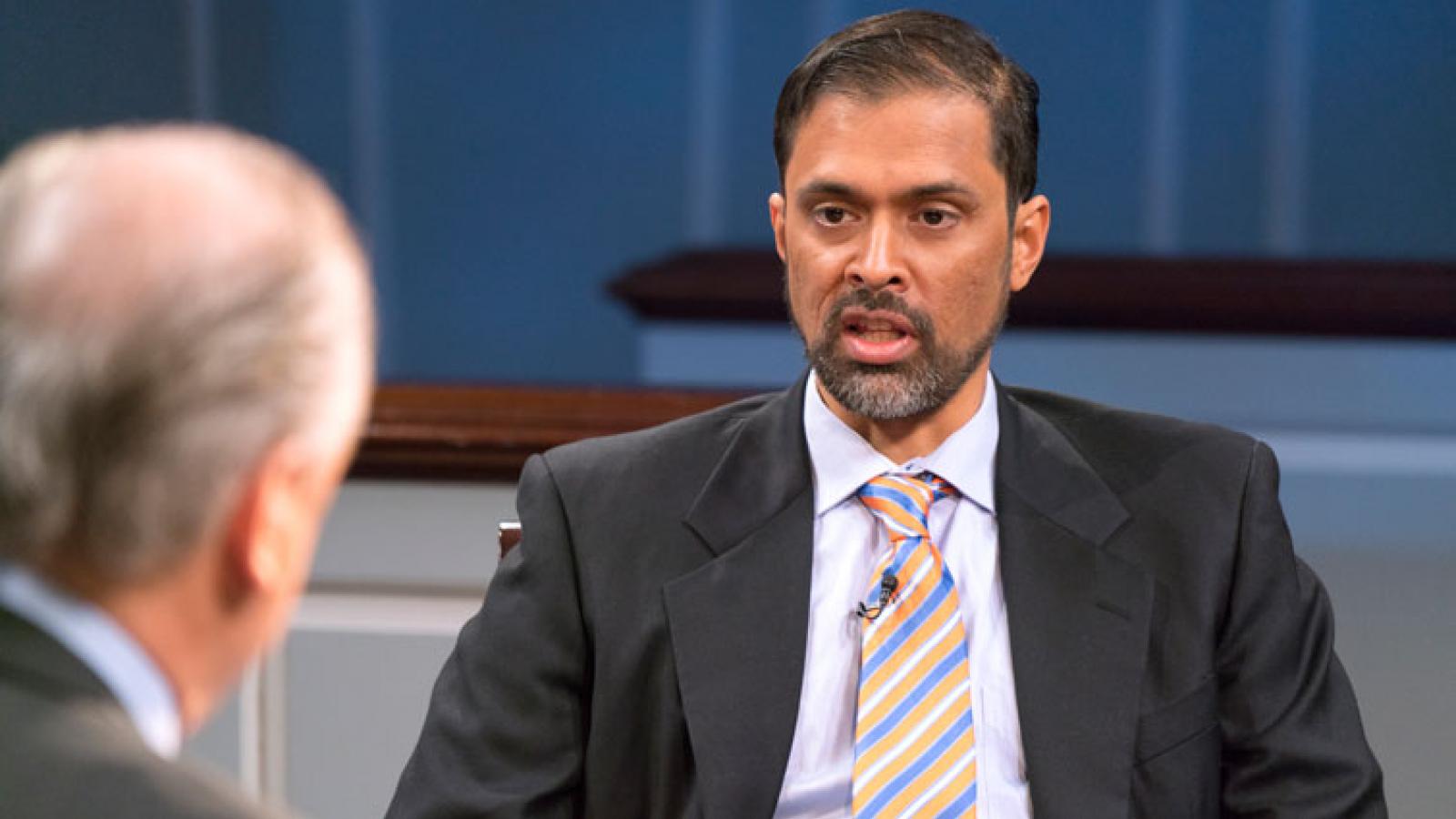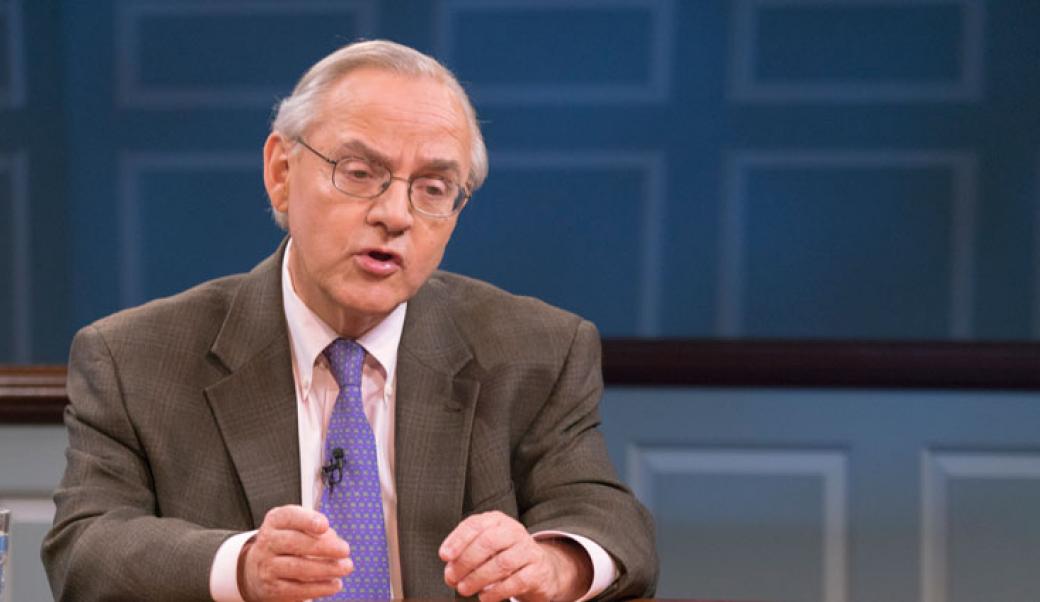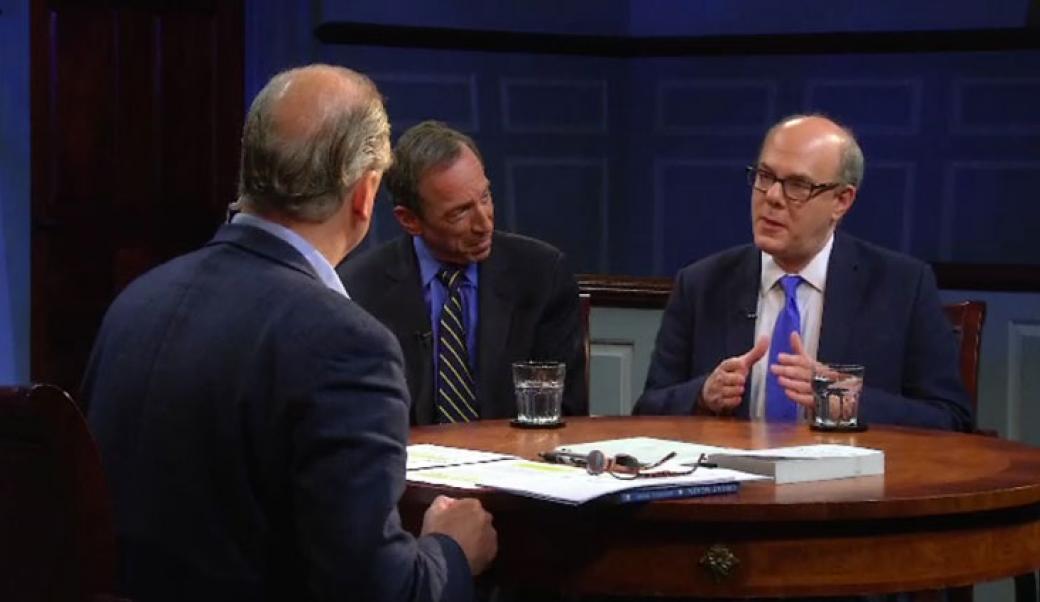About this episode
February 26, 2017
Saikrishna Prakash
Article II of the Constitution lays out the powers of the president. Although he can’t unilaterally declare war, he can send troops into some kinds of military action. The president sets foreign policy but is specifically prohibited from signing treaties with foreign countries without approval from Congress. But presidents have often challenged the limitations of their power. And some executive orders have changed our history in dramatic ways, such as the Emancipation Proclamation of 1863 or Harry Truman’s executive order abolishing racial discrimination in the military. In this episode of American Forum, we ask an eminent Constitutional scholar, Saikrishna Prakash of the UVA School of Law, a Miller Center senior fellow, about the limits of President Trump’s powers. Can he wipe out the Affordable Care Act, build a wall on the Mexican border, or deny entry to the U.S. for thousands of refugees all by himself? How do bold moves in the first weeks of the new Trump administration compare to the approaches of past presidents?
The First Year
First Year 2017: How much power does President Trump really have?
Transcript
Douglas Blackmon: Welcome back to American Forum. I’m Doug Blackmon. How much power does the President of the United States really have? With the stroke of a pen, presidents can block legislation supported by the vast majority of citizens or politicians. He can save the life of a condemned prisoner. The president can stop many things. But what can he decree must happen without input from anyone else? That question has simmered throughout American history. But right now, as the presidency of Donald Trump gets off to a dramatic start, it is already boiling hot. President Trump has issued a stream of executive orders that could dramatically change the future direction of the country, all of them with little or no input from the legislative branch of government. The powers of the president are laid out in Article II of the Constitution. He and presumably someday she can’t unilaterally declare war, but can send troops into some kinds of military action. The president sets foreign policy, but is specifically prohibited from signing treaties with foreign countries without approval from Congress. But presidents have often challenged the limitations of their power. Some executive orders have changed our history in the most dramatic ways, like the Emancipation Proclamation in 1863, ending legal slavery, or Harry Truman’s executive order abolishing racial discrimination in the military. In this episode, we ask an eminent scholar of the Constitution what the limits of President Trump’s powers really are.
THE QUESTION: What are the limits of presidential power?
Can he wipe out the Affordable Care Act, build a wall on the Mexican border, or deny entry to the U.S. for thousands of refugees, all by himself? How do these bold moves in the first weeks of his new administration compare to the approaches of past national leaders? And how has it worked out when presidents push the boundaries of presidential power? This program continues our special series, growing out of the First-Year Project here at the Miller Center, through which our scholars have spent the past eighteen months identifying key issues that would face the next president, gathering experts in those areas, and offering advice to all candidates on lessons from history applicable to any president, especially in their first year. Our guest is Saikrishna Prakash, a professor of law at the University of Virginia and the author of Imperial from the Beginning: The Constitution of the Original Executive. Thank you for joining us.
Saikrishna Prakash: Thank you, Doug.
3:14 Blackmon: Is this more or less dramatic a use of executive orders at the very beginning of a presidency than we’ve seen in recent times? Or is this roughly consistent with the history of presidents overall?
Prakash: Presidents, when they come into office, want to show that they’re engaged and active and that they are putting their policies into place, and they want to be able to tell their voters that, hey, I—I’ve done stuff that I said I was going to do. And the actions that he’s taken so far—he’s relying upon mostly statutory authority, some claim of constitutional authority.
FACTOID: Trump signed 12 Executive orders in first three weeks of presidency
But the idea is that statues require the executive branch to do various things and sometimes give discretion to the president, and he’s exercising that discretion in all these different executive orders.
4:00 Blackmon: So, talk for a second about the origins of all this. I mean, how is it that a president is able to do anything without some explicit mandate from Congress?
Prakash: It’s not so much that he’s claiming, I think, that the Constitution itself gives him the authority to decide how many regulations are issued or who gets to come into the country. It’s that, for the most part, Congress has delegated vast amounts of discretion to the executive, and he’s exercising it. But we’re not going to see an executive order that actually builds a wall, for instance, because he needs the money for that. He doesn’t have a pool of money from the Constitution itself that allows him to build a wall. And for that matter, he doesn’t have a—any constitutional authority, I believe, to decide who comes into the country. That’s a matter of statutory law. Congress has delegated vast amounts of discretion to the president over admissions into the United States, and he’s exercising that.
4:55 Blackmon: All right, let’s go way back in time. Let’s time machine back to the beginning of all this. And when the constitution is being written and approved, and Article II, which actually lays out the powers of the presidents—and does the Constitution say, "And the president is allowed to issue a certain number of king-like orders from the throne of the presidency?" I mean, is that explicit in the Constitution?
Prakash: No, of course not, Doug. There’s nothing about executive orders or issuing king-like orders. An executive order is no more than an order to executive branch officials to do something, pursuant to either the Constitution or statutes. And so, whenever the president issues and order, he’s saying, in effect, "I’ve got legal authority for this. Here it is, and here’s what I want you to do." The question in every single executive order, for people on the outside, is is he right that he has that constitutional or statutory authority? But no president has ever claimed the authority just to make law by virtue of an executive order. They’re always claiming to be enforcing the Constitution or exercising some statutory discretion.
5:59 Blackmon: And so—and so, we have seen, though, over time the—a kind of running debate over exactly what those boundaries are and how clear the statutory authority or constitutional authority has to be for the president to do these things. But there is, implicit in the Constitution and the way it’s been interpreted that areas of execution of governmental power that are not clearly assigned to other parts of the government, the president has a good deal of opportunity to claim power within those areas.
Prakash: Most of these orders have been under statutory discretion, not sort of an occupation of authority that’s sort of unclear. So, I think—you know, we have a state—we have a government—federal government now where there’s vast amounts of discretion delegated to administrative agencies, both executive and otherwise. And presidents and these agencies exercise that authority in various ways. And the thought has been that Congress can’t get itself involved in the details. There’s too much that Congress has to do, and it can’t sort of muddy its hands with the details. Or it doesn’t want to. It doesn’t want to take responsibility. And so, it’s pushed these responsibilities on the president, either because they think the president has expertise or the president can respond to changing events. And, you know, it’s not surprising that if you give someone responsibility, they’re going to exercise it.
7:24 Blackmon: But we have this running discussion in the country on a whole lot of fronts—executive orders are one that bring it up—of just what was it that the founders really had in mind when they wrote the Constitution? The Constitution doesn’t say a whole lot about a whole lot of things, you know? It’s a pretty loose document. And George Washington, as the first president, ended up being the architect of a whole lot of our traditions that are really as much a reflection of these early struggles over who has what power in the republic—more so that than explicitly what the Constitution said.
FACTOID: First three articles of the U.S. Constitution designate separation of powers
You’ve—in the research that you’ve done, which you’ve written about, you say that when you go back and look at the context of those times, that the presidency as imagined in the original Constitution is actually a much stronger one than what we have today. What do you mean by that?
Prakash: It’s stronger in some respects and weaker in others. So, there’s a story that’s sometimes told that the founders hated kings and they didn’t create a strong presidency. And I think that’s a mistake. By the time they wrote the Constitution, they had experience with weak executives in the states. And those weak executives didn’t look too good. A lot of the founders said, "We need to have a stronger executive at the federal level." And that’s what they created. The book basically argues that the presidency was stronger than many people today suppose, at the founding. What’s happened since the founding, of course, is just constitutional drift, right? If you’ve got a document that’s been around for 200 years, you’re going to have changes whether you like it or not, whether you even know it or not. And I’d say in some respects, the presidency is more powerful. In other respects, he’s less powerful. So, with respect to law execution, you had an executive at the founding that was really responsible for law execution across the board. They didn’t have these independent agencies like the Securities and Exchange Commission or the Federal Elections Commission that basically execute the law without regard to presidential wishes.
FACTOID: List of all federal departments and agencies can be found at USA.GOV
The president appoints people, but they kind of act as independent actors. Where the president’s clearly more powerful is war powers. The constitution grants Congress the power to declare war. And they meant by that not the power to issue some statement.
FACTOID: Article I, Section 8, Clause 11 gives Congress power to declare war
They meant by that the power to decide whether we’re going to wage war. And they understood that, and presidents understood that. Washington, Jefferson, Madison, they—whenever they wanted to wage war, whenever they wanted to start war, they went to the Congress first. And we’ve lost that sense, because a lot of people have a—inflated, I think mistaken sense of the commander-in-chief clause.
9:50 Blackmon: The term imperial presidency, in its current, most common use, is often associated with the Bush administration, the George W. Bush administration, as the—that was a presidency that asserted, in particular, more forceful powers over military actions.
FACTOID: Arthur Schlesinger’s 1973 history traced The Imperial Presidency
But the—but we actually have a running conflict since the 1960s between Congress and the president over who has this power to declare war or to enter into military engagements, and what is a war, what is a—clearly, a war involves a legal declaration of war. But what is something short of that, like Iraq or almost all of the conflicts that the United States has been involved in over the last fifty years. What would you say as to the original intention and how it would apply to the ongoing engagement in Iraq and Afghanistan that President Obama has continued to authorize, or the initiation of it under President Bush.
Prakash: In Iraq and Afghanistan, Congress passed statutes called authorizations to use military force, in 2001 and 2002.
FACTOID: The 2002 Iraq Resolution passed House 297-133, Senate 77-23
And Congress essentially told the president, "You can wage war, you know, in these countries." And so, those wars, I think, are examples where Congress has declared war. Or, more precisely, it’s used its authority under that clause. Part of my research indicated that you can declare war without using the words "declare war". You don’t need to use those words to actually exercise that authority. And I think that’s what Congress did in the early days of the Bush administration. By not putting any timeframe on those wars, they allowed presidents to continue them indefinitely. And that’s been our practice, right? If you go back to look at the declaration of war against Germany or Japan, there’s no sunset on those. And I think when people pass those authorizations, they thought, well, you know, this will last two or three years and we’ll be done. I don’t think anyone contemplated we’d be going on this long. But those two wars are examples of wars authorized by Congress. An example of a recent war that wasn’t was Libya. Libya, you know, was not authorized, either, I think, under the 2001 AUMF or the Iraq AUMF.
FACTOID: 2011 military intervention in Libya was led by NATO coalition
And that’s where the president acted more in line with his predecessors, his recent predecessors, in deciding to wage war against Muammar Gaddafi without congressional authorization.
12:05 Blackmon: But if we think in terms of the issues that are going to face President Trump in this year, the kinds of scenarios that he is likely to encounter would be, for instance, either a terrorist attack that—there appears to be some specific association with a particular geography or a particular regime in the world.
But if we look at another kind of scenario, that Russia decides to move a boundary in the Baltics or that Russia were to decide to acknowledge the Russian-speaking sections of the Ukraine that have been fighting against the Ukrainian government, those seem like fairly logical, plausible things almost to expect as a test of the United States early in this presidency.
FACTOID: Recent troop buildup on Russian border is largest since Cold War
If President Trump wanted to land American forces somewhere in response to that kind of a small but highly significant movement, is that something he can do? Or would he need to do a Franklin Delano Roosevelt and go to Congress and ask for broad authority?
Prakash: So, I—Doug, it’s deeply contested now, right? I think at the founding, if you wanted to go put troops somewhere on the border of a country that he thought he might be engaging, you know, in military action against, he’d have to go to Congress. But today, people tend to think—a lot of people tend to think—not everybody, but a lot of scholars tend to think that the president has authority to place troops wherever he or she wants to, and that the president can engage in provocative acts that might result in warfare, even if, you know, the other nation hasn’t attacked the United States. So, for the last forty or fifty years, people have a more—have a broader sense of what the commander-in-chief can do than they did at the founding. And you mentioned what if we get attacked, right? Do we—does the president need to get authority? And I think at the founding, the answer was yes. He could defend the United States territorially, but he couldn’t go to war against a foreign nation merely because they attacked, because there was a question: are you going to attack in response? We don’t think about that now, because we’re the 800-pound gorilla. We have a lot of—we’re very powerful. But back in the old days, right, when we were a weaker nation, we paid tribute to countries because we didn’t want to wage war against them. And so, there was always a question, right? Are we going to wage war against the Barbary Coast states? Are we going to pay them? And that was a question that Congress had to decide, not the president.
FACTOID: U.S. wars in North African barbary states started in 1801 and 1815
We’re far removed from that context, both in terms of our strength as a country, but also in terms of what we think the president can do. I think if you asked, you know, 99 out of 100 presidential scholars, they would say that if the United States is attacked, the president doesn’t need to go to Congress to get a declaration of war. So, we’re just in a different mindset when it comes to warfare, our place in the world, and the president’s ability. And so, he’s going to benefit from that.
14:47 Blackmon: So, all of that fits into what I think you described. It’s not just as simple as the Congress approves a law that then the president executes, but that there is a kind of—that the boundaries of the separations are actually more grey than they are precise lines, and that there is an anticipation of a kind of human engagement between these branches of the government. And so, it is a kind of holistic approach to these powers, in particular, exactly what—the boundaries of the president’s power may, in fact, move around, to some degree, but—there’s clearly the awarding of that power, but also an expectation of engagement between these different branches. Is—I mean, is that a fair way to describe that?
Prakash: That’s a very fair way, Doug. I would say that, as compared to most scholars, I see less blurry lines than some. But everybody who reads the Constitution understands that there are blurry lines, even at the founding, right? Because people at the time are disputing what the president can or can’t do. It’s not as if they all speak in one voice as to what the president can do. I just find a little more certainty than some folks. And then, when you flash forward over 200 years, you know, that scope of uncertainty’s naturally going to increase, right? Because what we tend to do in presidential powers today is we try to find an example of a president doing something similar and saying, "Well, he did it, so I get to do it."
16:09 Blackmon: But all of this, does it suggest that the—you know, back to this issue that comes up over and over again of originalism and who is an originalist as it relates to the Constitution? Usually, we talk about that just in the context of appointees to the Supreme Court or to major court positions. And is someone a believer in the idea, as—Justice Antonin Scalia maybe was the most famous originalist—and this idea that we can’t interpret away from what the—how the founders perceived these original founding documents and the way that they would work. Other people saying the world has changed too dramatically over 200 years. But what does all of what we’ve been talking about say in terms of the originalism discussion?
Prakash: You know, originalism is appealing to some, because they feel like what’s the point of having a Constitution if the words don’t change but the meaning of the Constitution changes, right? So, we don’t change the declare war clause, we just say the president can now start wars, even though that’s what it meant to declare war. If you have that kind of regime, I think the problem is the words no longer matter, right? And in what sense are we using—in what sense are we under the Constitution of the founders if we adopt new meanings for the phrases and words in the Constitution? And I think, you know, this appeals to many people, even people who have sympathies for the living Constitution or the idea that the Constitution should change over time. Because, like, occasionally, they will say, well, this is just not consistent with what the founders wanted. And I think there’s a sense in which, you know, if we’re going to keep this Constitution, we’ve got to sort of stay true to it. And then, of course, there’s also a sense that it doesn’t always work for today’s times. And that’s the tension that people have. And different people work that out in different ways.
17:56 Blackmon: But over time, different presidents have taken, themselves, rather different views of what the Constitution laid out in terms of these executive powers. You write about Teddy Roosevelt and the stewardship theory, where Roosevelt and other—several other presidents had this kind of school of thought of—that if it is for the good of the country, then the president can execute that power.
FACTOID: Roosevelt signed executive orders to create 150 national forests
But what are the—if you had to say the two or three approaches that presidents have—or the theories that presidents have adopted about what their power is, what would those be? There’s that one, an activist Roosevelt one. But what would the others be?
Prakash: Theodore Roosevelt thought, "I should be able to do anything that furthers the interest of the people, unless there’s some specific provision in law or the Constitution which says I can’t." So, it was sort of, like, you’ve got to tell me I can’t do it or I’m going to do it. And that’s a very expansive notion of law, of presidential power, because there aren’t provisions that specify everything that the president can’t do. Taft, who went on to become Chief Justice of the Supreme Court, the only person to serve both as president and chief justice and—or a justice, for that matter—had a more sort of narrow sense of the president’s power.
FACTOID: Taft was president from 1909-1913 and chief justice from 1921-1930
I think he had a sense that was more Washingtonian. The president wasn’t a weak creature, but he didn’t have, you know, the authority to do whatever he thought was right unless a statute told him not to.
19:13 Blackmon: And so, as we get into—so, we look at the modern presidents beyond Roosevelt and Taft. The first Roosevelt and Taft. It is clear that, say, if we just look at the first year of presidencies, this fast start, Franklin Roosevelt issued 573 executive orders of some sort in his first year.
FACTOID: FDR signed 3,522 total executive orders, most of any president
But then, that quickly falls off over the ensuring presidents. And of the last seven or eight of them, Barack Obama is—had only forty-one, George W. Bush fifty-six. But it’s a kind of thirties, forties, fifties, sixties, kind of—the number of orders in the first year for the last—you know, all the way back to John F. Kennedy, really.
Prakash: Well, Doug, I think it’s a mistake to focus on the numbers, because, you know, the numbers don’t tell the whole story. The question is what directions are the presidents giving—are presidents giving to their underlings? And if that takes the form of a letter or an oral order, it’s just like an executive order. The executive order is different—that is has some permanence, right? If President Trump doesn’t overturn an Obama executive order, it still applies. And that’s not necessarily true of oral orders, right? But in terms of whether the president’s doing things, what really matters is the sum of all these sort of orders, whether they’re in writing, whether they’re oral, whether they’re—take the form of executive order or not.
20:32 Blackmon: And so, if we disregard the numbers, I think—certainly conventional wisdom is—and I think it’s true—that if we look at the substance of orders, that President Obama, in his second term, for sure, has been a heavier—has made heavier use of executive orders, and that—the attempted exercise of executive power—even than he himself did in his first term— [Prakash: Right, right.] —and—than some other recent presidents.
FACTOID: Of Obama’s 276 executive orders, 129 were signed in second term
Prakash: I mean, my intuition is there are drawbacks and benefits of executive orders, right? The benefit is you can do so unilaterally because you think you have constitutional or statutory authority. What’s the drawback? The drawback is the next president can come in and repeal it. If it’s—if you go to Congress and get a statute, they can’t easily repeal the statute. And so, it’s a temporary fix, but it’s unilateral, pursuant to statutory authority. A statute is more permanent, and the next president can’t just issue an order, right, that gets rid of it.
21:30 Blackmon: You uh, you played a part in the Miller Center’s First-Year Project that I described in the introduction. If I’m right, you actually participated in one of the briefings of early Trump transition folks. As I’ve heard it described, at least, they were very interested in this question of executive power and sort of the boundaries of that, and what’s possible and what’s not. But in broad strokes, what sort of advice did you give to the Trump transition people as they were trying to explore the boundaries of executive power?
Prakash: Well, we gave—you know, the team here is crackerjack, and they had spent, you know, years working on this project. And I was brought in at the tail end. And so, you know, I didn’t have the level of expertise they had about the first 100 days. And I was, you know, asked to speak to the Trump people. And I spoke about some of the orders and letters that prior administrations issue upon first entering office, right? So, there’s policies you want to change, but there’s also policies you want to stop from changing. At the end of a—administration, there’s—particularly when there’s a transition between parties, the outgoing administration is running at breakneck speed to get out rules and regulations and to have them take effect. Because once they take effect, you have to go through this long and laborious process to undo them.
FACTOID: President Trump signed freeze on new regulations after inauguration
Before they take effect, you can stop them with the stroke of a pen. And so, I talked to them a bit about how prior administrations had basically put in a freeze from minute one in order to give themselves a chance to review pending but not final rules, rules that hadn’t yet taken effect.
23:05 Blackmon: That was some months ago, I think. You know, as—now you’ve seen the—this administration come into power and get going.
If you were back on the phone with the Trump people today or the new Trump people today and they were saying, "What’s—you know, what’s your advice now, Sai, about going forward with these kinds of things?" What would your message to President Trump or his advisors be?
Prakash: I would focus on the process, because I think the process hurt them, independent of those two questions. I think you’ve got to run these orders by the various departments, even though there’s a chance that people within the department will leak the order and sabotage them. I mean, imagine if the government’s consistently sending out immigration executive orders without talking to the department that’s responsible for it. I don’t think the people that he’s recruited to be secretaries in these various departments are going to stay if all they’re being asked to do is defend decisions that they had no input in making.
24:00 Blackmon: And so, if that moment—if you actually were in a conversation with President Trump and Reince Priebus or—and the opportunity was there for you to make—to offer them a message that was not so much practical but almost philosophical. What would be that philosophical message?
Prakash: You know, Washington is a great example. Washington did things that were controversial, and he was criticized for doing things. But he always thought he was acting consistent with the Constitution and pursuant to the best interest of the country. Even if President Trump, you know, is very careful about his legal claims and legal conclusions and his administration is, as well, he’s going to be criticized. I think the point is to be dutiful, to be conscientious, just as Washington was. And so, that’s a great example of someone who really thought about what he was doing in a deep way and thought about what was right for the country, and then acted accordingly. Whatever—you know, and he let the chips fall where they may.
24:55 Blackmon: Sai Prakash, thanks for joining us.
Prakash: Good to be here, Doug.
Blackmon: We hope you’ll join us for future editions of American Forum, where our focus is always on the presidency, how our national leadership can be most effective, no matter what party they represent, and our belief that if Americans will listen and talk to each other, even when they disagree, everything will work out better for everyone. You can be part of these conversations by joining us at the Miller Center Facebook page, visiting MillerCenter.org, or following us on Twitter. My handle is @DouglasBlackmon. Or you can watch us on any of more than 200 PBS affiliates across the U.S.A. I’m Doug Blackmon, see you next week.
